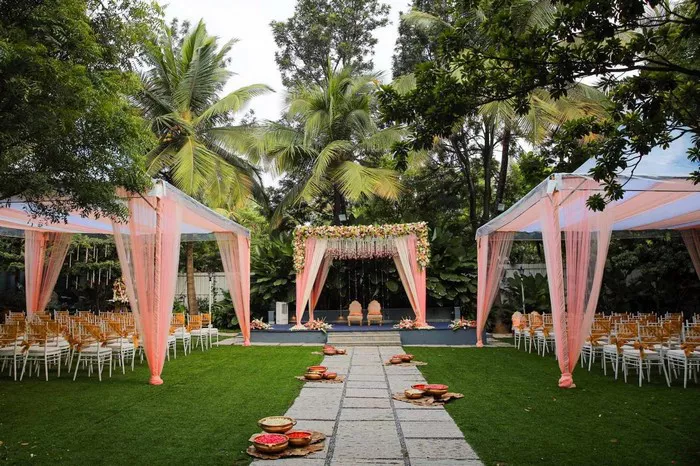A remarkable shift is occurring in the wedding industry as divorced, widowed, or never-married couples over 50 are creating a boom in “second chapter” weddings – celebrations that break all traditional rules while honoring hard-won life experience. These aren’t your parents’ vow renewals; they’re full-scale weddings reimagined through the lens of maturity, financial stability, and self-knowledge. Industry analysts report a 47% increase in weddings among couples aged 55-75 since 2020, sparking new trends that are influencing the broader matrimonial market.
What makes these celebrations unique starts with their intentionality. Unlike first marriages often shaped by family expectations, second chapter weddings reflect deeply personal choices about everything from guest lists to ceremony structure. Nearly 80% of these couples opt for non-traditional venues, with vineyards, art galleries, and private home gardens topping the popularity list. The average budget exceeds $35,000 – not because of extravagance, but because these couples prioritize quality experiences over obligatory formalities. Many choose to invest in exceptional catering (72% select premium open bars with craft cocktails), live entertainment (jazz trios and acoustic performers outnumber DJs), and professional photography that captures their story authentically rather than through youthful fantasy filters.
The fashion revolution in this demographic is particularly striking. Gone are the stiff tuxedos and poufy white dresses – instead, couples are commissioning custom outfits that reflect their personal style at this life stage. Women frequently choose elegant pantsuits or cocktail-length dresses in bold colors, while men experiment with textured fabrics and relaxed cuts. The “no white” rule has been thoroughly discarded, with many brides opting for metallic, jewel-toned, or patterned gowns. Some daring couples coordinate their outfits as complementary ensembles rather than traditional bridal/groom looks. Jewelry often incorporates heirloom pieces in modern settings, symbolizing the integration of past and present.
Ceremonies themselves undergo radical reinvention. Nearly 65% of second chapter weddings feature personalized rituals replacing standard exchanges of vows. Some couples write letters to their younger selves that they read aloud; others create time capsule ceremonies where guests contribute wisdom for future generations. Blended families are honored through “family weaving” rituals where children and grandchildren participate in symbolic binding of different colored cords or ribbons. Many ceremonies include memorial elements for previous spouses or important figures who’ve passed, striking a poignant balance between honoring history and celebrating new beginnings.
The reception experience differs markedly from traditional weddings as well. These events tend to run longer (5-6 hours average versus 4 for first weddings) with more emphasis on meaningful interaction than rigid scheduling. Seated dinners are declining in favor of gourmet food stations and interactive dining experiences like chef’s tables or build-your-own small plates. Entertainment skews toward activities encouraging connection – wine blending stations, group painting projects, or even ballroom dance lessons replacing the standard dance floor free-for-all. Playlists carefully balance contemporary tracks with nostalgic hits from the couple’s youth, creating a multi-generational musical journey.
Perhaps most significantly, second chapter weddings are pioneering new approaches to guest participation. Instead of conventional registries, many couples create “experience funds” for future travels together or charitable donations in guests’ names. Some institute “no gifts” policies entirely, requesting instead that attendees bring handwritten advice or recipes. A growing trend sees couples gifting their guests – often with customized items reflecting shared history or inside jokes rather than generic favors. The traditional seating chart disappears in favor of lounge-style groupings designed to spark interesting conversations among guests who may not know each other.
This movement is reshaping the wedding industry in unexpected ways. Vendors report increased demand for mature models in advertising and more inclusive marketing language. Venues are creating packages specifically catering to smaller, more sophisticated gatherings. Photographers develop specialized techniques to flatter aging features naturally rather than relying on heavy retouching. Even the language around these events is changing, with terms like “encore weddings” and “wisdom weddings” entering the industry lexicon.
Financial planners note an interesting economic dimension: where first weddings often represent financial strain, second chapter weddings frequently reflect careful planning and disposable income. Many couples pay entirely for their own celebrations, removing family politics from the equation. Some strategically time their weddings to retirement account distributions or property sales, treating the event as both celebration and smart financial planning.
The cultural impact extends beyond the wedding day itself. These couples are normalizing later-in-life romance and challenging stereotypes about aging and relationships. Their celebrations often include public declarations about embracing new beginnings at any age, serving as inspiration for younger guests. Many incorporate elements of personal growth – displaying artwork they’ve learned to create, performing music they’ve recently mastered, or sharing stories of self-discovery that led them to this moment.
As baby boomers continue redefining life stages and Generation X enters its prime wedding years, the second chapter wedding trend shows no signs of slowing. Industry forecasts predict it will account for nearly 30% of all weddings by 2028, potentially surpassing first marriages in certain demographics. What began as a niche market has blossomed into a cultural phenomenon proving that love stories – and the celebrations that honor them – only grow richer with time. These weddings aren’t just events; they’re powerful statements about resilience, reinvention, and the timeless human capacity for joy.
The ripple effects are already visible, with younger couples borrowing elements from these celebrations – the emphasis on authenticity over tradition, the creative ceremony structures, the focus on guest experience over formality. In this way, second chapter weddings aren’t just celebrating individual love stories; they’re quietly revolutionizing how our culture thinks about marriage celebrations at every age and stage. The message is clear: when it comes to weddings, there are no rules – only opportunities to craft meaningful moments that reflect who you are and the life you’ve built.


